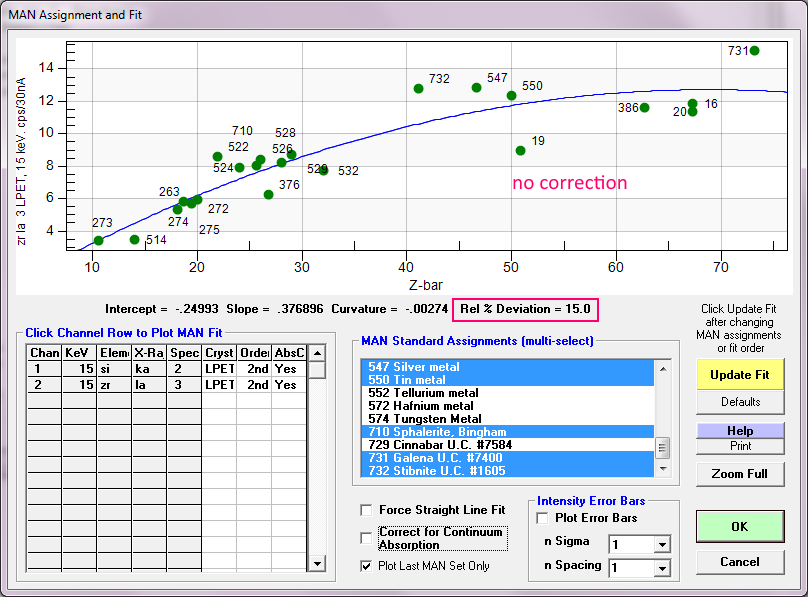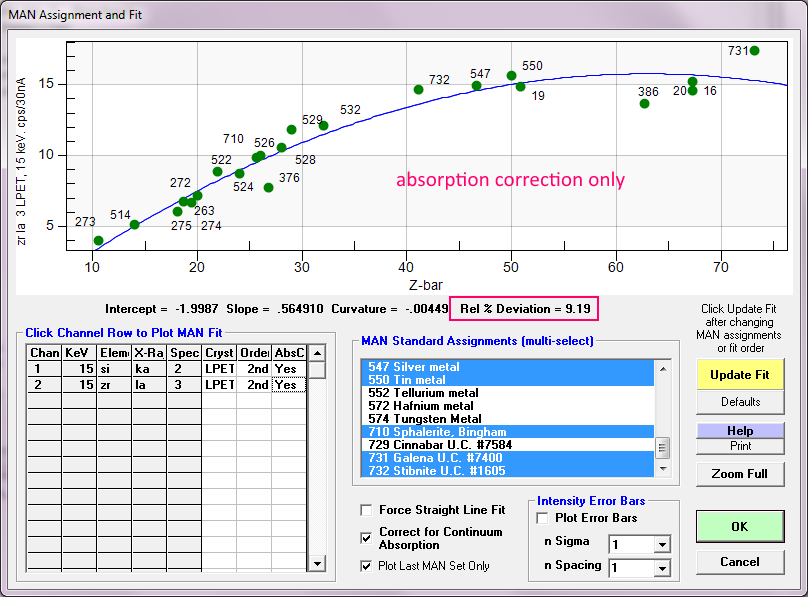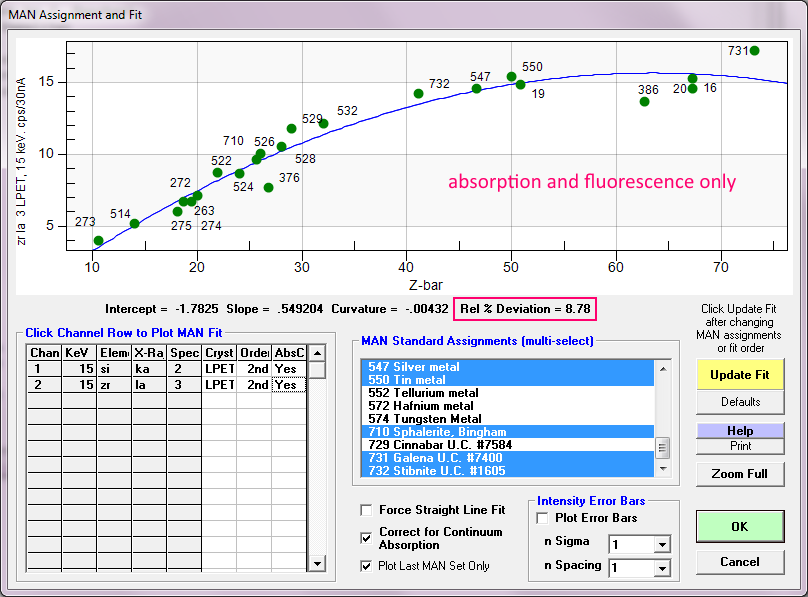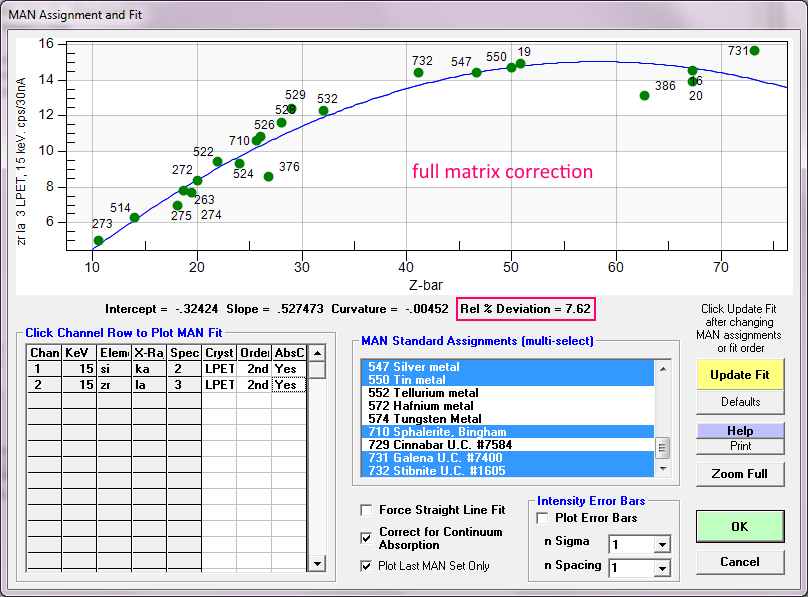Jakub and Ben,
Nice work. You have caused me to re-examine the correction for continuum matrix effects and we should work on this together. But first a little history.
When we first came up with the MAN background correction it was just a simple linear fit vs. Z-bar to deal with the fact that we had some fixed monochrometers permanently tuned to specific emission lines which could not be detuned off-peak to measure the background (necessity is a mother!). This was back in the mid 1980s. About 8 years later I was at an M&M conference and was explaining to John Armstrong how we were doing this mean atomic number (MAN) background method, and he said to me: "Are you doing a correction for continuum absorption to the standard intensities?", and I said "uh, no". But it made perfect sense that one should do that since the continuum *generated* in each standard will depend only on the average Z (Kramer's Law), but the continuum actually *emitted* by each standard will depend on the composition (Beer's Law). So as soon as I got home I added a continuum absorption into the code.
Because continuum x-rays are emitted somewhat differently than characteristic x-rays, the first thing I tried was a simple continuum absorption correction from Heinrich modified by Mycklebust, but that actually made the MAN fit worse! It was a very primitive calculation. So then I tried using just the absorption correction term from the normal matrix correction calculations, since the energy of these continuum emissions are essentially the same energy as the characteristic emission! Hey, you do what you have to!

That actually worked pretty well and in almost every case produced a better fit to the MAN intensities, so we decided to just utilize that. That was 25 years ago!

Fast forward to 2016, when Jared Singer and I wrote this up and we included John Armstrong as a co-author to thank him for his suggestion to add a correction to the continuum intensities for the MAN fit:
https://epmalab.uoregon.edu/publ/A%20new%20EPMA%20method%20for%20fast%20trace%20element%20analysis%20in%20simple%20matrices.pdfSo here are data from a test run I did recently to look at backscatter coefficients on some standard materials, but I had included a few analyzed elements just for fun. So looking at one of these emission lines, here are the Zr La MAN intensities measured on a number of standards, *without* any correction to the continuum x-rays:

Next, here are the same intensities but corrected for absorption (only) using the absorption correction term from the matrix correction physics for each standard:

That is a significant improvement over doing no correction at all to the MAN standard intensities! And that's where things stood until now. But now you guys are pointing out (correctly I should add!) that we really should also be looking at continuum fluorescence, because the continuum can fluoresce other characteristic x-rays in the MAN standards (and of course the unknowns as well!), that might (if we are unlucky), be the same energy as our analytical emission line and be detected by the spectrometer. And correct me if I am wrong, but it seems to me that we don't need to worry about backscatter loss or stopping power calculations since this is just x-ray physics.
Now I don't have any code laying around to do a proper treatment for continuum absorption and fluorescence, but thinking back to my early efforts, I decided to try the fluorescence correction term for each standard (yes, I know it shouldn't work), along with the absorption correction term, from the normal matrix correction calculations, and here is what we get:

Well, I'll be darned. That's even a better fit!
OK, let's get really crazy and just for fun, let's throw in the atomic number correction term as well, and now we get this:

Dang, that's even better! I realize that this makes no sense at all from a physics perspective, but please try it out yourselves and please let me know what you find. And if someone can come up with a proper continuum absorption/fluorescence correction, I would be thrilled to try it out!
But I think it's important to keep in mind that all these corrections to the MAN background are quite small, and also they are essentially normalized out when we perform the actual MAN correction. Because although we correct each MAN standard intensity for the matrix effects on the emitted continuum by multiplying the MAN standard intensities times the matrix correction (prior to the MAN fit regression), we then divide the unknown MAN intensity (derived from the MAN standard fit), by the unknown matrix correction!
For those reading all this that haven't thought about this stuff as much as Jakub and Ben have, the steps are:
1. Correct each MAN (continuum) standard intensity for the matrix correction physics for that standard (or whatever physics you want to use).
2. Calculate the fit coefficients for these corrected continuum intensities as a function of the average atomic number of each standard.
3. During the (unknown) sample matrix iteration, calculate the average Z of the unknown sample.
4. Determine the background intensity from the MAN standard fit coefficients based on the current unknown sample average atomic number.
5. De-correct the calculated unknown sample MAN intensity by the matrix correction (or whatever physics you want) for the current unknown composition.
6. Subtract the de-corrected unknown sample MAN intensity from the measured on-peak sample intensity
7. Repeat steps 3 to 6 until the MAN calculation converges...
It's so simple!

I think the first step is to look at the x-ray physics and see if we can try and understand what is it about these compositions that cause them to fall below the general trend of the MAN fit. It could be fluorescence, but it could also be related to how we calculate average atomic number! For example, we already know that we *cannot* utilize mass fractions for calculating average Z for backscatter coefficients, as shown here:
https://probesoftware.com/smf/index.php?topic=1111.msg8249#msg8249Remember to log in to see the pdf attachment. I'll be presenting on this at M&M next month. I've played around with using a Z fraction weighting for calculating average atomic number for MAN plots and haven't found anything that works as well as plain old mass fraction weighting, but maybe it's a combination of absorption/fluorescence and average Z weighting for the continuum issues we are seeing...
Try looking at the A/Z ratios for the elements in these compounds, and take a look at the "alternative" Zbar calculations in the Output | Calculate Alternative Zbars menu in the Standard application.
And finally if we want to utilize the MAN background correction for high Z materials, please remember that accuracy can be problematic. Which is why for best accuracy one should always combine the MAN correction with the blank correction using a suitable blank standard. For zircon a synthetic zircon works excellently.